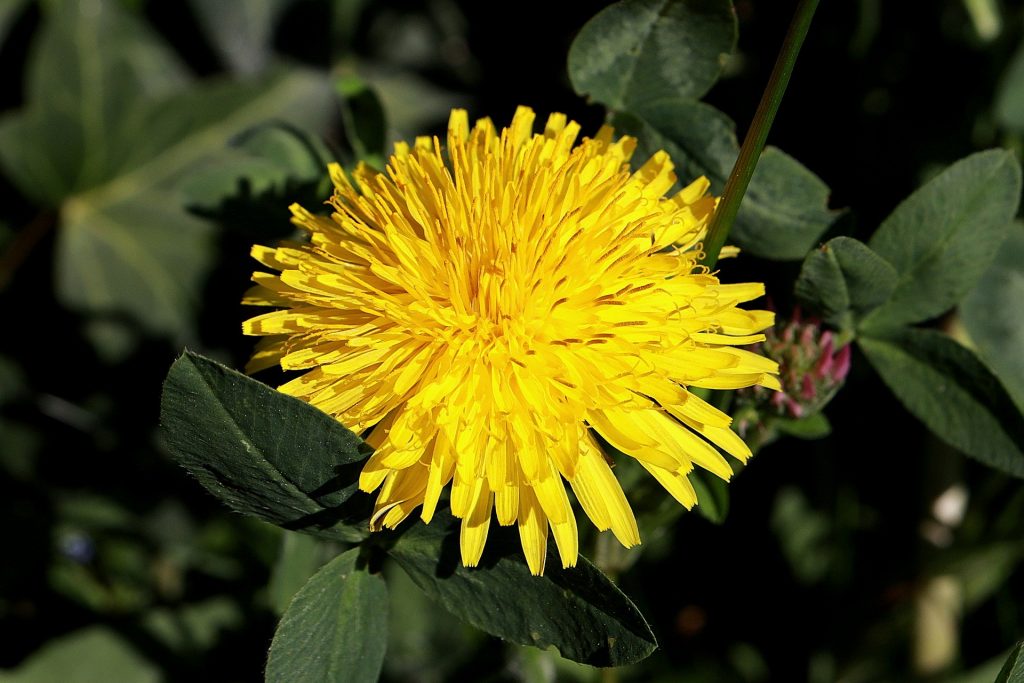
Keeping your lawn free of weeds is the holy grail of lawn care. After all of the effort you put into growing a beautiful lawn, the last thing you want is a few stray weeds ruining your perfect turf. Unfortunately, broadleaf weeds are some of the hardest weeds to beat. No single method will take care of all your weeds, and sometimes a few weeds are inevitable. But with the right cultural practices and appropriate weed control, you can acheive your goal of controlling broadleaf weeds and keeping your turf nearly 100% clear of weeds.
What Are Broadleaf Weeds?
The term broadleaf weeds covers a wide range of weeds. But what stands out most about broadleaf weeds is that they don’t look at all like grass, unlike some other weeds like crabgrass. Many broadleaf weeds have flowers, and they can be very challenging to eliminate. Broadleaf weeds include the notorious dandelion as well as milkweed, thistle, clover, wild violets, and many others.
Broadleaf weeds are divided into annual, biennial, and perennial weeds.
Annual weeds germinate from seed, grow, mature, give off new seed, and die all within 12 months.
Biennials live for two years. In the first year, they germinate from seed and form rosettes, and over their first winter, they store food in their roots. In the second year, they flower and go to seed before dying off.
Perennials live for more than two years and can reproduce vegetatively, without seed. In addition to going to seed, perennials spread through underground structures such as roots, rhizomes, and bulbs. This can make perennials extremely difficult to kill off completely.
Where Do Broadleaf Weeds Come From?
Broadleaf weeds are pervasive. You can find broadleaf seeds in almost all soil, and the seeds can remain viable for up to thirty years. Even if you don’t have any broadleaf weeds nearby, your lawn is not safe. Broadleaf weeds release thousands of tiny seeds, and they can travel on the wind. Your lawn could receive seeds from broadleaf weeds miles away.
You can also unintentionally introduce broadleaf seeds into your lawn. Almost any topsoil you being into your lawn for landscaping will include some broadleaf seeds. If you purchase inexpensive grass seed, broadleaf seed may actually be mixed into the box or bag of seed. That’s why it is crucial to purchase only certified turf from trusted growers, like the growers of The Turfgrass Group.
![Controlling Broadleaf Weeds in Your Lawn [infographic]](https://theturfgrassgroup.com//wp-content/uploads/2020/05/Controlling-Broadleaf-Weeds-in-Your-Lawn-infographic-scaled.jpg)
Herbicidal Treatment of Broadleaf Weeds
There are a number of herbicides on the market for controlling broadleaf weeds. However, not all herbicides work on all weeds species. So most consumer broadleaf herbicides are actually a formulation of multiple herbicides to treat as wide a range of weeds as possible. Most consumer herbicides are made up of 2,4-D, MCPP (mecoprop), and dicamba (Banvel).
When to Apply Herbicide
The best time for applying a general-purpose broadleaf herbicide in the fall as plants are beginning to go dormant for winter. In the Southeast, that is often October and November. Herbicides are most effective at that time because, as plants prepare for winter, they move food and energy reserves into their roots and stems for storage over winter. The herbicide you apply will be carried with the energy stores deep into the roots, where it is most effective at killing the entire plant.
If you missed applying herbicide in the fall, the second-best time to apply is late spring or early summer. This way, the plants have flowered and can absorb the herbicide better than without flowers. However, if you use herbicide in the spring and summer, you need to be very careful around other plants. Herbicide can damage trees, flowers, and vegetable gardens. Even if you don’t drip the herbicide directly onto your trees and flowers, the herbicide can drift on a breeze and damage your plants. It is best to carefully spot-apply the herbicide if it is anywhere near plants you want to keep.
Precautions When Using Herbicide on Turfgrass
Remember that herbicide may also damage turfgrass if it is applied too liberally. Be careful to apply herbicide when the grass is not stressed. Do not use when soil moisture is low, or during unusually hot or cold weather. Also, never apply herbicide to new sod or newly planted seed. If it rains within 24 hours of the application, wait ten days before you reapply. If, after ten days, there is no apparent effect from the herbicide, you can attempt another application. Do not attempt to reseed a bare spot left by weed removal until the soil has been well-soaked by either rain or irrigation. Also, don’t mow for three days before or three days after applying herbicide.
Cultural Practices to Treat and Prevent Broadleaf Weeds
Herbicide is not the only tool for controlling broadleaf weeds. Cultural practices can also make it more difficult for broadleaf weeds to grow in your lawn.
Mowing
To help crowd out weeds, keep your grass long. TifTuf Bermudagrass and JaMur Zoysiagrass can be mowed up to two inches, while Zeon Zoysiagrass does best at one and a half inches. Longer grass allows less light for weed seeds.
Also, make sure to mow frequently enough that you never remove more than one-third of the grass blade height. Frequent mowing reduces stress on the turf. Healthier, sturdier turf grows strong, deep roots that can outcompete weeds for water and nutrients.
Irrigation
Instead of regular light watering, irrigate your turf deeply but infrequently. Irrigate until the soil is moist to the full depth of the turf roots. Then, wait until the grass is showing the first signs of drought to water again. The early signs that indicate it’s time to water again are a blueish-gray hue to the grass and footprints that remain in the grass after you walk on it. Deep, infrequent irrigation trains roots to grow deep, so they outcompete other plants, including weeds.
Fertilization
A thick, lush lawn is the best way of controlling broadleaf weeds and preventing weeds from taking hold. Make sure to fertilize appropriately to get the densest grass possible. TifTuf Bermudagrass and many of our other varieties do best with 1 to 2 pounds of fertilizer per 1000 ft2 a year, split evenly between spring and fall applications.
Shade
Many broadleaf weeds start in the shade, where they grow best. From there, they spread to take over your lawn. By reducing shade in your lawn and growing shade-tolerant turf in shaded areas, you can prevent broadleaf weeds from taking hold. TifTuf Bermudagrass is more shade-tolerant than most bermudagrass, and Zeon Zoysiagrass is one of the most shade-tolerant varieties of warm season grass. Learn more about growing turf in the shade here.
Thick, Healthy Turf Withstands Weeds
The best way to prevent weeds is to maintain a thick, healthy lawn. As we mentioned above, a healthy lawn starts with high-quality seed or sod, like the sod from The Turfgrass Group. Whether you choose the drought-resistant TifTuf Bermudagrass, the shade-loving Zeon Zoysiagrass, the plush feeling JaMur Zoysiagrass, or any of our other varieties, you will be rewarded with a lawn that weeds will find hard to take hold in. You can find a grower for any of our varieties here.
